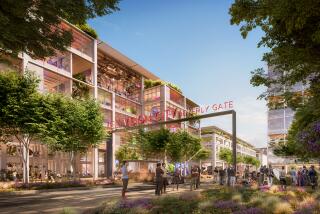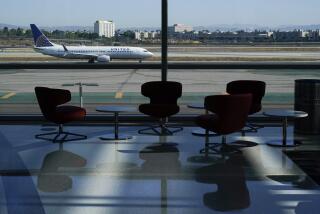Turbulence Rocks Proposal to Replace Airport’s Terminal
- Share via
BURBANK — A slate of public hearings on the proposed new Burbank Airport terminal has been postponed, but the delay may be the least of the problems facing the project.
Since it was announced Aug. 3, the compromise deal for a modern, $300-million terminal has come under fire from the Federal Aviation Administration, the airlines, homeowner groups and politicians--including three members of Congress and Los Angeles City Atty. James Hahn.
“This plan is being attacked from every direction on the compass,” said Charles Lombardo, a Burbank representative on the Burbank-Glendale-Pasadena Airport Authority.
That’s not the way it was scripted.
After years of wrangling, Burbank city officials and Airport Authority members on Aug. 3 signed a “Framework for Settlement” on a replacement terminal. The deal would allow construction of a terminal with up to 19 airline parking gates, provided airport officials meet noise-reduction measures sought by Burbank.
Officials scheduled a round of public hearings on the proposal, hearings that had been scheduled to conclude next month with a pivotal vote before the Burbank City Council.
But only one public hearing was held--on Aug. 19. Now hearings are set for early November and March 16.
The deal may drag out even longer as proponents of the terminal try to obtain consent from both the FAA and the airlines while going through a new zoning approval process and environmental reviews, said Peter Kirsch, an attorney representing the city of Burbank on airport issues.
Kirsch and others say the delay is not an attempt to regroup and rebuild support for the project, but instead simply reflects the complexity of the issue.
“[A November vote] was a political statement of desire, not a statement of practicality,” Kirsch said. “For anyone to suggest that this deal would not have bumps or would be a love-fest is incredibly naive.”
Most agree the 1930s-era terminal building, situated just 250 feet from the airport’s east-west runway, needs to be replaced. The subject of the most intense debate, however, has been the size and scope of the project.
Negotiators came up with several key proposals to limit aircraft noise, which was at the heart of the long fight between Burbank Airport and surrounding residents. The proposals included:
* Building a 14-gate terminal, with a gradual expansion to 19 gates, provided the airport can get an FAA-approved overnight flight curfew and lower average noise levels to below 65 decibels in the surrounding neighborhoods.
* Closing the terminal building to incoming flights between 11 p.m. and 6 a.m.
* Requiring a phaseout of noisier “Stage II” aircraft.
* Making permanent a 1986 ban on easterly takeoffs.
One of the first to question the plan was the Air Transport Assn., the airline industry group, which said a nighttime terminal closure was a backdoor attempt at a flight curfew. Such curfews cannot be implemented without exhaustive noise studies.
The ban on easterly takeoffs was attacked by Reps. Howard Berman (D-Mission Hills), Brad Sherman (D-Sherman Oaks) and Henry Waxman (D-Los Angeles). The trio said it would force more noise on their constituents in areas such as North Hollywood, Studio City and Sherman Oaks. They urged the FAA to block the deal.
Hahn also jumped into the fray and threatened to file suit against the plan unless officials agreed to conduct a new environmental study.
The proposal also drew criticism from Burbank residents. Some residents argued that the City Council sold out their interests. Former Burbank Councilman Ted McConkey led efforts to qualify a local ballot initiative that would require a mandatory curfew at the airport.
More to Read
Sign up for Essential California
The most important California stories and recommendations in your inbox every morning.
You may occasionally receive promotional content from the Los Angeles Times.










